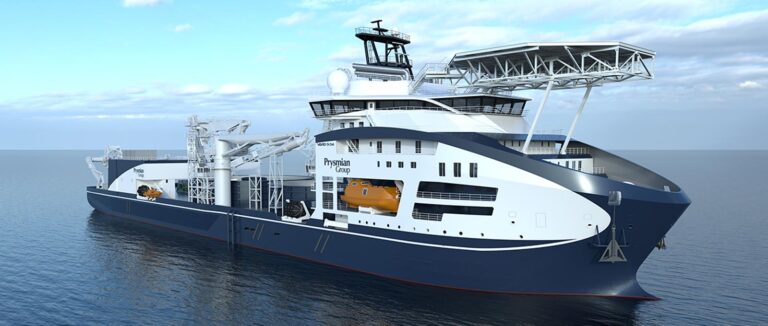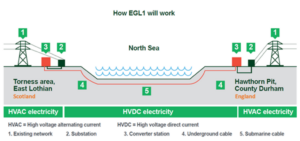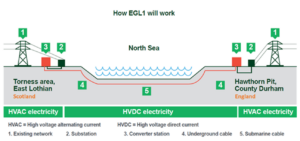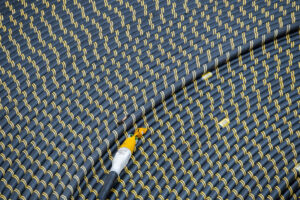Home Subsea UK’s $3.2 billion subsea electricity superhighway embarking on construction works this winter
While pursuing ways to strengthen its energy security and reach net zero goals, the United Kingdom (UK) is developing new infrastructure, such as high voltage direct current (HVDC) cable connections, to enable power grids to run on renewables. One such HVDC project, which will bring more green electricity to Britain from wind farms off the shores of the UK, is set to enter the construction phase in winter 2024.
 Prysmian’s Leonardo da Vinci cable laying vessel; Source: Prysmian
Prysmian’s Leonardo da Vinci cable laying vessel; Source: Prysmian
Eastern Green Link 1 Limited, a joint venture between the UK transmission grid owners SP Transmission and National Grid Electricity Transmission, is nearing the end of the development phase for the Eastern Green Link 1 (EGL1) network development project between Scotland and England, with construction planned to begin this winter.
After receiving planning permission, a joint venture company was formed to deliver the project, which recently became the first one to proceed under Ofgem’s fast-track process and receive a provisional £2 billion funding package. Last year, Prysmian got a contract, worth around €850 million, to provide the cable systems, after being selected as the preferred bidder for the EGL1 cable link.
With the total investment for the joint construction project being £2.5 billion (almost $3.2 billion), of which National Grid’s share is £1.5 billion (over $1.9 billion), the 2 GW EGL1 HVDC electricity superhighway will run from the Torness area in East Lothian to Hawthorn Pit in County Durham, via the North Sea.
Upon completion, the project is expected to carry enough electricity for 2 million homes, unlocking Scotland’s renewable energy reserves by scaling up Britain’s capacity to transport clean energy from where it is generated to where it is needed, increasing the resilience and stability of the UK’s transmission networks in the process.

Posted: 2 months ago
The Scottish point of connection in the Torness area in East Lothian entails a new onshore converter station adjacent to existing industrial facilities and a connection into a new substation near Branxton to tie into the existing transmission network. Underground electricity cables are expected to be installed to connect the substation to the converter station and from the converter station to the landfall point south of Thorntonloch Beach.
Furthermore, the marine cable route covers the installation of 176 km of subsea cables from south of Thorntonloch Beach, through Scottish and English waters to a landfall point just north of Seaham, in County Durham. On the other hand, the English point of connection encompasses underground onshore cables, which will be installed from the landfall point just north of Seaham to a new converter station and substation at Hawthorn Pit, County Durham, between the villages of Murton and South Hetton.
In addition, several existing overhead line connections into the substation at Hawthorn Pit will be reconfigured, resulting in fewer pylons than there are today. The consortium of GE Vernova’s Grid Solutions business and MYTILINEOS Energy & Metals got a hold of a £1 billion contract in December 2023 to deliver the HVDC converter stations for the Eastern Green Link 1 project.
Based on the project’s existing timeline, minor preparation works, predominantly at Hawthorn Pit, have recently begun in the project area ahead of the construction of the converter station and substation and installation of the underground cable. This is slated to be wrapped in autumn 2024.

Posted: 5 months ago
According to the JV, the first stage of vegetation clearance has been completed to prepare the project area. As part of the next steps in Murton and South Hetton, ground investigations on the proposed substation and converter station sites are currently being undertaken. The second stage of vegetation clearance, archaeological surveys, and ground investigations were also planned at the converter station site.
Moreover, the main construction phase is set to kick off in winter 2024, enabling the creation of the converter station and substation, along with the underground cable installation. The offshore installation activities will require the deployment of Prysmian’s cable-laying vessel of the Leonardo da Vinci class.
The main construction phase is due for completion in 2029. EGL1 is said to reinforce the UK’s efforts to reach 50 GW offshore wind power generation by 2030, lending the country a helping hand to achieve its net zero by 2050 aspiration. With its multi-directional design, the project is anticipated to be put into operation mode in 2029.
While nearly 400 km of power cable is needed for the 194 km route between the two countries, the biggest portion of the 176 km part of the route is expected to be installed offshore in the North Sea with onshore sections of around 8 km and 10 km in Scotland and England, respectively.
The UK is also making headway in progressing another HVDC cable connection, Eastern Green Link 2 (EGL2), which is said to be the longest ever built in Great Britain. The construction works are on track to begin this autumn.

long read
Posted: 25 days ago
A few days ago, the EGL 2 project’s marine survey activities resumed, with the start of a detailed geophysical survey to identify potential unexploded ordnance.
>>> Read full article>>>
Copyright for syndicated content belongs to the linked Source : OffshoreEnergy – https://www.offshore-energy.biz/uks-3-2-billion-subsea-electricity-superhighway-embarking-on-construction-works-this-winter/










